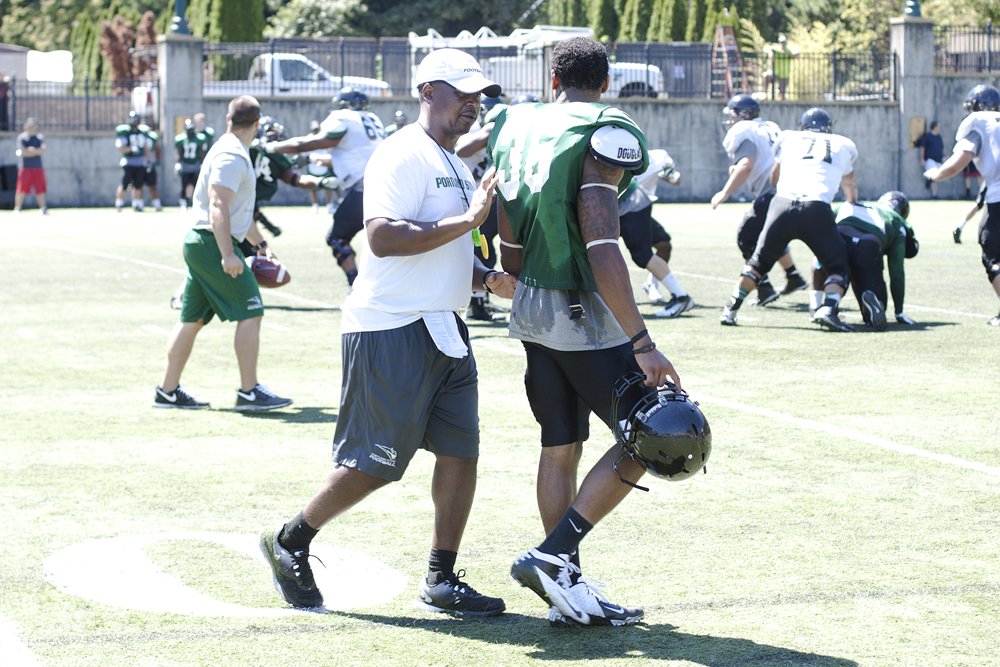Appalachian State’s 34-32 victory over Michigan a month ago left many questioning whether Football Championship Subdivision (FCS) teams had finally gained a measure of parity with teams in the Football Bowl Subdivision (FBS).
A class system
Appalachian State’s 34-32 victory over Michigan a month ago left many questioning whether Football Championship Subdivision (FCS) teams had finally gained a measure of parity with teams in the Football Bowl Subdivision (FBS).
For casual fans, the Mountaineers’ stunning upset begged another question: what’s the difference between the two subdivisions? The question gains more relevance following the Vikings’ 52-17 loss Saturday to San Diego State, an FBS team.
Split personality
Since Portland State joined the Big Sky Conference in 1996, the football program has competed at the FCS level, the same level as the Mountaineers.
Vikings head coach Jerry Glanville said he sees greater parity between and within the two divisions.
“Especially when Appalachian State plays a Big Sky team (after the Michigan game) and they were tied in the fourth quarter,” Glanville said. “I think it’s kind of unique that they beat Michigan, but when they got back and played (an FCS team), they had a struggle.”
Up until last season, the FCS was known as Division I-AA, while the FBS was known as Division I-A, or simply D-I. Football is the only sport in Division I that has subdivisions.
“There’s a very strong misperception and that’s why they changed the name. There started to be a misnomer that if you played in I-AA it was more like a second division,” said athletic director Torre Chisholm. “We’re all Division I. We just play a slightly different format in football.”
For example, Portland State plays Division I basketball, and on any given year could make the NCAA Tournament in March, where the Vikings would be in contention for a national championship.
“I feel that I-AA, there’s so many talented athletes in America and you know, not everyone can go to a I-A school,” said wide receiver Kenneth Mackins. “It’s really competitive. A lot of the I-AA teams are beating I-A teams in some of the weaker conferences and some of the bigger conferences.”
Key differences
There are two key differences between FCS and FBS teams.
First, FCS teams are limited to 63 scholarships, whereas FBS teams may award 85 scholarships. Also, FCS teams may break up their 63 scholarships to award money to more student athletes, something FBS teams may not do.
Chisholm said part of the reason Portland State competes at the FCS level is it provided the university a “better gradual step in terms of number of scholarships.”
“What happens is, Oregon and Oregon State will get the best kid coming out of high school. The kid that we’ll get, we’ll have lift weights, we’ll have to get faster, and you hope that by the time our players are juniors, anyone would take them,” Glanville said.
Also, FCS teams use a 16-team playoff structure while FBS teams compete for the national title via nationwide polls and the Bowl Championship Series (BCS) and its top five bowl games, including this year’s debut of the BSC championship game.
Glanville said he likes the playoff format of the FCS.
“Where the beauty of this is you’re going to play for it, nobody’s going to vote on it and if you stumble a couple of games and still get in the playoffs, you can end up being the champion,” Glanville said. “I don’t understand why everyone wouldn’t do it this way. This is like the NFL, the last team standing wins it.”
Paid to play
Each year, Portland State plays one or more “guarantee games” that bring in thousands of dollars in appearance fees, a practice Chisholm said most schools participate in. Typically, schools with enough money and attendance will offer a big payday as an incentive to smaller schools to play a tough road game.
Two years ago, Portland State played at Oregon State and Boise State and earned $330,000.
Last year, football games against New Mexico, California and Oregon brought in $1 million, and the men’s basketball team got $130,000 in appearance fee money for their guarantee games.
“That was a fluke. We already had one game scheduled, and Cal came to the school and presented an opportunity to play and shortly after that Oregon comes. We’re not going to turn down a chance to play Oregon,” Chisholm said. “Last year was really unusual.”
Even so, Chisholm said that PSU will play at least one guarantee game in each season. The Vikings played their lone guarantee game Saturday as it absorbed a lopsided loss to the Aztecs.
Before the loss, Glanville said he did not believe that fans perceive PSU to be playing a lower level of football.
“I look at us, I never think anybody looks at us as anything but the best football there is,” he said. “I don’t think our perception is anything but this is big-time football.”




